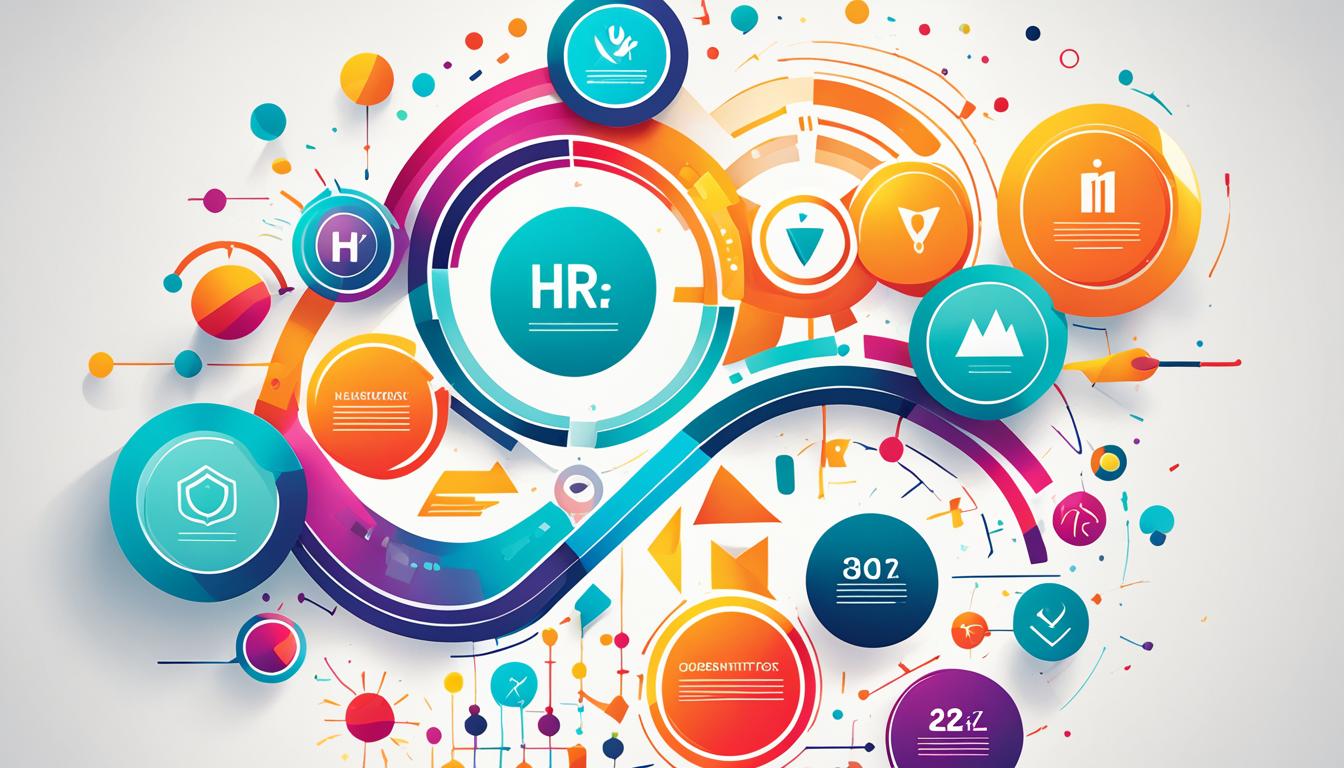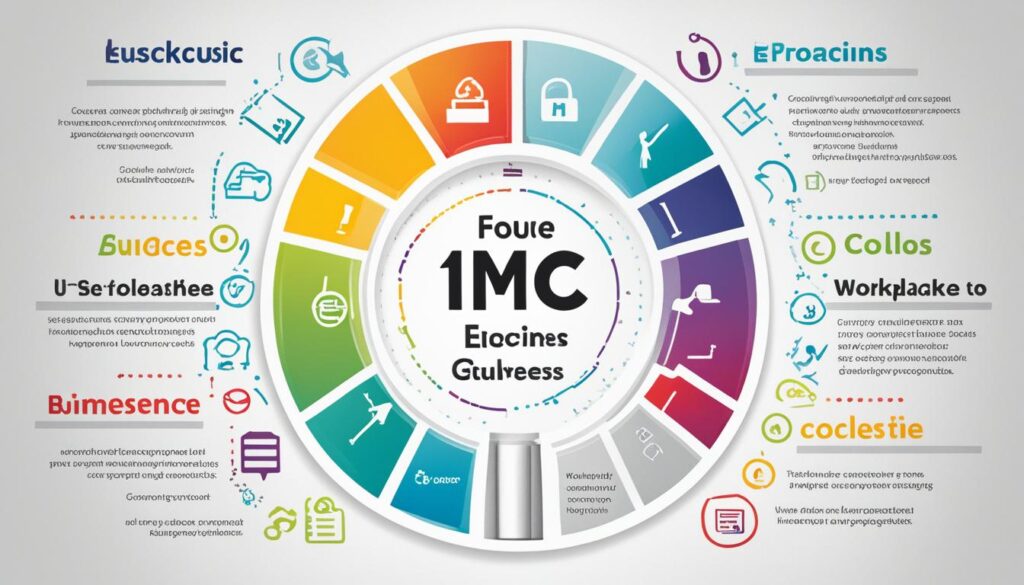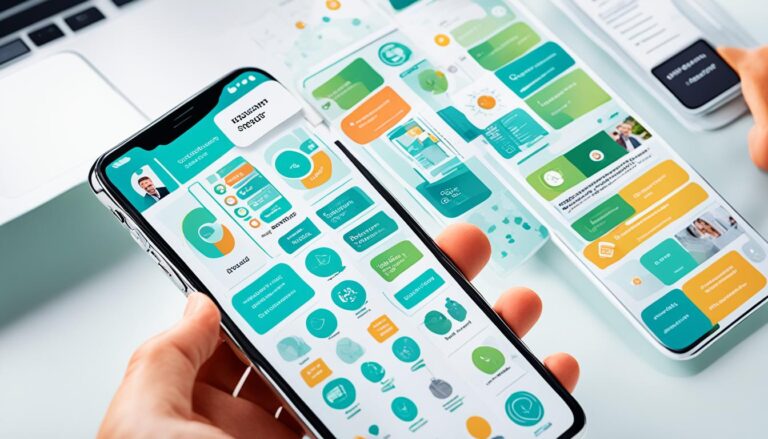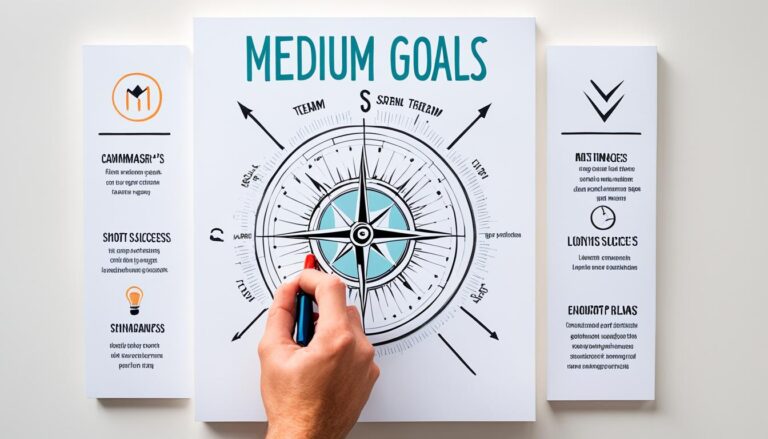Unlock HR Success: Key Components for Effective Goal-Setting

Have you ever wondered what sets successful HR teams apart? How do they consistently achieve their goals while driving employee performance and organizational success? The secret lies in effective goal-setting. But what are the key components for unlocking HR success through goal-setting in the HR planning process?
Strategic planning, employee performance, and goal alignment play a vital role in shaping an organization’s HR strategy. By setting clear and meaningful goals, HR teams can unleash their full potential, drive employee engagement, and elevate their performance to new heights. So, let’s explore the essential components that ensure effective goal-setting and propel HR teams to unparalleled success.
Key Takeaways:
- Clear and meaningful goals enhance employee performance and drive organizational success.
- Goal alignment ensures that HR efforts contribute to the organization’s strategic objectives.
- SMART goals and HR metrics provide a framework for effective goal-setting.
- Strategic thinking, market research, and teamwork are essential skills for HR professionals.
- Different types of goal-setting methods offer flexibility and adaptability in the HR planning process.
Importance of Goal Setting in HR Planning
Goal setting plays a vital role in HR planning. It provides direction, focus, and clarity to both employees and the organization. When HR goals are clearly defined, employees understand their roles and how their efforts contribute to the organization’s success.
By setting and effectively managing goals, HR teams can create a positive and high-performing workforce. Here are a few key reasons why goal setting is important in HR planning:
- Organizational Success: Setting goals helps organizations achieve their objectives and fulfill their strategic vision. By aligning HR goals with organizational goals, HR teams can contribute to the overall success of the organization.
- Employee Engagement: Clear goals provide employees with a sense of purpose and direction. When employees understand how their work contributes to larger organizational objectives, they feel more engaged and motivated to perform at their best.
- Productivity: Goal setting promotes a goal-oriented work environment where employees focus on results and tangible outcomes. This fosters productivity by providing employees with a clear roadmap for their work.
- Goal-Oriented Work Environment: When goals are prioritized and communicated effectively, it creates a culture where employees are continuously striving for improvement. A goal-oriented work environment encourages innovation, collaboration, and a growth mindset.
When HR teams prioritize goal setting in the planning process, they lay the foundation for a successful and thriving organization. By providing employees with clear goals, HR professionals can empower individuals to contribute their best, align their efforts with organizational objectives, and foster a culture of excellence.

| Benefits of Goal Setting in HR Planning | Key Takeaways |
|---|---|
| 1. Organizational Success | – Alignment with organizational goals. – Contribution to strategic vision. – Fulfillment of objectives. |
| 2. Employee Engagement | – Sense of purpose and direction. – Motivation to perform at best. – Understanding contribution to larger objectives. |
| 3. Productivity | – Focus on outcomes and results. – Clear roadmap for work. – Channeling efforts effectively. |
| 4. Goal-Oriented Work Environment | – Encourages innovation and collaboration. – Drives continuous improvement. – Cultivates a growth mindset. |
Essential Skills for Effective Business Goal-Setting
To ensure effective goal-setting in the HR planning process, HR professionals need to develop specific skills that enable them to set meaningful and impactful goals. These skills are crucial for aligning goals with the organization’s mission and driving success. Let’s explore the essential skills for effective business goal-setting:
1. Strategic Thinking
Strategic thinking allows HR professionals to envision the big picture and understand how goals fit into the overall organizational strategy. By thinking strategically, HR professionals can identify the key objectives that will contribute to long-term success and guide the goal-setting process.
2. Market Research
Market research skills are essential for setting goals that are relevant to the market landscape and business environment. HR professionals need to conduct thorough market research to identify opportunities, assess threats, and understand the areas for growth. This research provides valuable insights that inform decision-making and goal-setting.
3. Resource Allocation and Time Management
Efficient resource allocation and time management skills are vital for effective goal-setting. HR professionals must optimize the use of available resources and prioritize tasks to ensure that goals are attainable and realistic. By effectively managing resources, HR teams can maximize productivity and achieve desired outcomes.
4. Teamwork
Strong teamwork skills are crucial for collaboration and alignment across departments. Setting effective business goals requires input and cooperation from various stakeholders within the organization. HR professionals need to foster a collaborative environment where teams can work together towards common objectives, ensuring that goals are well-integrated and synergistic.
5. Adaptability and Flexibility
Adaptability and flexibility are essential skills for goal-setting in a dynamic and unpredictable business environment. HR professionals need to be able to adjust goals and strategies to changing circumstances, keeping the organization on track for success. This flexibility allows for agile goal-setting that can respond to evolving market conditions and organizational needs.

Incorporating these essential skills into the goal-setting process enables HR professionals to set impactful and meaningful goals. By strategically thinking, conducting market research, optimizing resource allocation, fostering teamwork, and embracing adaptability, HR teams can set goals that drive organizational success.
| Skill | Description |
|---|---|
| Strategic Thinking | Envision the big picture and align goals with the organization’s mission. |
| Market Research | Identify opportunities, threats, and areas for growth through comprehensive research. |
| Resource Allocation and Time Management | Optimize resource utilization and prioritize tasks to ensure goal attainment. |
| Teamwork | Promote collaboration and alignment across departments to achieve common objectives. |
| Adaptability and Flexibility | Adjust goals and strategies to changing circumstances and evolving organizational needs. |
Different Types of Goal-Setting Methods
When it comes to goal setting in HR planning, there are several effective methods that HR professionals can utilize. By choosing the right goal-setting approach, HR teams can ensure clarity, alignment, and increased chances of success. Let’s explore some popular goal-setting methods:
- SMART Goals: The SMART goals framework emphasizes setting goals that are Specific, Measurable, Achievable, Relevant, and Time-bound. This method provides a clear roadmap for goal attainment, ensuring that goals are well-defined and realistic.
- BHAGs (Big, Hairy, Audacious Goals): BHAGs focus on setting ambitious and inspiring long-term goals that push the boundaries of what seems achievable. These goals spark motivation, drive innovation, and encourage employees to go above and beyond.
- Backward Goal Setting: This approach involves starting with the end goal in mind and working backward to develop a strategic plan. By identifying the desired outcome first, HR professionals can create actionable steps to achieve the goal effectively.
- OKRs (Objectives and Key Results): OKRs are a goal-setting method that sets quarterly objectives and measurable key results. This approach ensures that goals are aligned with organizational objectives and enables clear tracking of progress.
- One-Word Goal Setting: Sometimes, simplicity is key. With one-word goal setting, employees choose a single word that represents their overarching focus for the goal-setting period. This method helps maintain clarity and keeps individuals centered on their primary objective.
Each goal-setting method has its own unique advantages and can be implemented based on the organization’s needs and preferences. Experimenting with different methods can help find the most effective approach for setting and achieving HR goals.
| Goal-Setting Method | Key Characteristics |
|---|---|
| SMART Goals | Specific, Measurable, Achievable, Relevant, Time-bound |
| BHAGs | Ambitious, Inspirational, Long-term |
| Backward Goal Setting | Start with the end goal and work backward to develop a plan |
| OKRs | Quarterly objectives, Measurable key results |
| One-Word Goal Setting | Choose a single word to represent the primary focus |

Employee Goal Setting in HR
Employee goal setting is a critical responsibility of HR managers. It involves setting specific and measurable goals that align with the employee’s role, professional aspirations, and the organization’s objectives.
When it comes to goal setting, it’s important to ensure that goals are both specific and measurable. Specific goals provide employees with clear direction and a sense of purpose, while measurable goals allow for tracking progress and evaluating success.
One type of employee goal setting focuses on personal growth. These goals go beyond an employee’s immediate work responsibilities and allow for individual development. Examples of personal growth goals include attending professional development workshops, acquiring new certifications, or taking on cross-functional projects.
Another type of goal setting is professional development goals. These goals are aimed at enhancing the skills and competencies that are relevant to the employee’s current job or future roles within the organization. HR managers can support professional development by providing training opportunities, mentorship programs, or performance feedback.
In addition to individual goals, HR managers can also set team-focused goals. These goals aim to improve collective skills within a department or team to enhance overall performance. Examples of team-focused goals include increasing collaboration, improving communication, or fostering a culture of innovation.
By setting and supporting employee goals, HR managers can drive improvement in employee performance and contribute to the organization’s success. When employees have clear goals that align with their aspirations and the organization’s objectives, they are more likely to be engaged, motivated, and focused on achieving their targets.
Examples of Employee Goal Setting
| Goal Type | Examples |
|---|---|
| Personal Growth Goals | Attend a leadership seminar, learn a new programming language, complete a project management course |
| Professional Development Goals | Improve presentation skills, expand knowledge of industry trends, acquire project management certification |
| Team-Focused Goals | Enhance collaboration within the marketing team, improve cross-functional communication, drive innovation in product development |
Setting goals and helping employees achieve them is a powerful way to drive success and growth within an organization. By prioritizing employee goal setting and providing the necessary support and resources, HR managers can unlock the potential of their workforce and contribute to the overall success of the organization.
How to Define Goals for Employees
When it comes to defining goals for your employees, it is crucial to ensure alignment with your company’s objectives. By setting goals that are in line with your organization’s mission and vision, you create a sense of purpose and direction for your employees. This alignment motivates them to work towards the overall success of the company.
One effective approach is to involve your employees in the goal-setting process. This collaborative approach allows them to provide input and feel a sense of ownership over their goals. When employees actively participate in defining their goals, they are more invested in achieving them and feel a stronger connection to the organization.
While setting goals, it is important to be realistic and considerate of the unique roles and available resources of your employees. Setting realistic goals ensures that your employees are not overwhelmed and can achieve them within a given timeframe. By taking into account their individual strengths and limitations, you can set challenging yet attainable goals that push them to reach their potential.
However, goals shouldn’t only be focused on the company’s objectives. It is also essential to incorporate personal development goals for your employees. Personal development goals allow employees to grow both personally and professionally, fostering a sense of continuous improvement. They provide opportunities for skill enhancement, career progression, and a sense of fulfillment.
Defining goals for employees should be done in a comprehensive and thoughtful manner. By considering alignment with company objectives, collaboration with employees, realistic goal setting, and personal development, you can create a goal-setting process that empowers your employees and drives success.

| Benefits of Defining Goals for Employees | How to Implement |
|---|---|
|
|
Conclusion
Effective goal setting is a crucial element of HR planning that directly contributes to HR success and overall organizational performance. By setting clear, specific, and measurable goals, HR professionals can align employee performance with the organization’s objectives, creating a pathway for success. However, achieving successful goal setting in HR requires the development of essential skills, the utilization of various goal-setting methods, and effective collaboration with employees.
By prioritizing goal alignment, clarity, and continuous evaluation, HR teams can unlock their full potential and transform strategies into tangible results. It is essential for HR professionals to acquire skills such as strategic thinking, market research, resource allocation, teamwork, and adaptability to ensure effective goal setting within the HR planning process. These skills enable HR professionals to visualize the big picture, make informed decisions, and foster collaboration across departments.
Utilizing different goal-setting methods, such as SMART goals, BHAGs, backward goal setting, OKRs, and one-word goal setting, offers flexibility and adaptability to suit the organization’s needs and preferences. Incorporating employee input and fostering collaboration is vital in defining goals that align with company objectives and individual aspirations. Supporting personal development alongside performance goals promotes employee growth and engagement.
By implementing an effective goal-setting phase in the HR planning process, organizations can improve employee performance, enhance overall organizational success, and foster a culture of excellence. When goal-setting is approached strategically and with a focus on employee alignment and development, HR teams can unlock their potential to drive growth and achieve long-term success.






